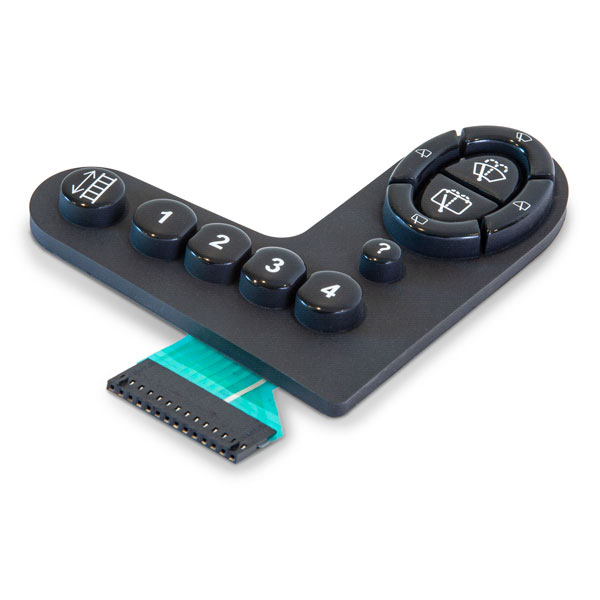Membrane Switch: Reliable, Cost-Effective, and User-Friendly Control Systems
Membrane Switch: Reliable, Cost-Effective, and User-Friendly Control Systems
Blog Article
Comprehending Membrane Switches Over: The Secret to Reliable and sturdy Controls

What Are Membrane Switches?
Membrane layer buttons are a sophisticated solution in the realm of interface innovation, incorporating performance and design seamlessly. These gadgets function as an interface between individuals and digital systems, integrating numerous elements right into a compact format. Commonly created from adaptable, thin layers of materials, membrane switches are developed to react to touch, enabling customers to connect with equipment and digital tools efficiently.
The key elements of a membrane layer switch include a published circuit layer, visuals overlay, and a spacer layer that protects against unintended activation. The visuals overlay can be customized to mirror brand identification or user choices, improving aesthetics while making sure use. Membrane switches are generally made use of in different applications, consisting of medical tools, consumer electronic devices, and industrial devices, owing to their longevity and resistance to environmental aspects such as dampness and dirt.
Among the vital benefits of membrane buttons is their capability to endure deterioration, making them ideal for high-traffic settings. In addition, they are lightweight and require marginal space, permitting ingenious layouts in item development. In general, membrane switches represent a reliable and useful choice for modern-day electronic user interfaces, weding technology with user-centric design principles.
How Membrane Layer Changes Work
The procedure of membrane layer switches hinges on a simple yet efficient device that translates individual input right into electronic signals. When an individual presses the button, the top layer warps, enabling a conductive component in the circuit layer to make call with a corresponding conductive pad on the bottom of the graphic overlay.
The design of membrane buttons can vary, however they often incorporate domes or responsive aspects to provide comments to the individual, enhancing the general experience - membrane switch. The products made use of in membrane switches, such as polyester or polycarbonate, add to their sturdiness and resistance to environmental factors, consisting of wetness and dust. Additionally, the printed circuits are normally encapsulated, which secures them from deterioration over time.
Advantages of Membrane Switches

Additionally, membrane layer switches are recognized for their durability. Built from durable materials, they are immune to dust, moisture, and physical wear, which significantly extends their life-span compared to typical mechanical switches. This resilience makes them specifically appropriate for high-traffic environments and applications needing durability.
Another considerable benefit is the convenience of cleaning and maintenance. The smooth surface of membrane layer switches decreases dust accumulation and is commonly unsusceptible spills, making them excellent for settings that require frequent sanitization.
In addition, membrane layer switches provide a structured profile, leading to a thinner design that can be incorporated right into different gadgets without including mass. This function not just improves the visual allure yet pop over here likewise contributes to a more ergonomic product layout.
Applications of Membrane Layer Switches
Versatile and easy to use, membrane buttons find applications throughout a large range of markets, including medical gadgets, customer electronics, and industrial devices. In the medical area, these buttons are important to gadgets such as analysis devices, person tracking systems, and mixture pumps, where reliability and ease of cleaning are vital. Their capacity to stand up to harsh environments and maintain performance makes them perfect for you can try here such applications.

In consumer electronic devices, membrane layer switches are utilized in items like microwaves, cleaning devices, and push-button controls - membrane switch. Their streamlined design allows for instinctive interface, improving the total user experience while offering sturdiness and resistance to tear and use
Industrial tools likewise gains from membrane switches, especially in control panels for equipment and automation systems. These buttons offer protection versus dust and moisture, making sure consistent efficiency in difficult atmospheres. Their adjustable functions permit suppliers to customize them to certain functional demands, improving performance and capability.
Picking the Right Membrane Layer Switch Over
When choosing a membrane switch, it is necessary to think about various aspects that affect performance and suitability for specific applications. The key factors to consider include ecological problems, responsive responses, longevity, and design specifications.
First, evaluate the operating environment; buttons subjected to moisture, chemicals, or severe temperature levels call for particular products to make sure durability and capability. Next, evaluate the need for responsive responses. Relying on customer communication, some applications may gain from a tactile reaction to validate activation, while others may choose a non-tactile style for visual factors.
Toughness is an additional important factor; membrane switches should be designed to withstand constant usage, influences, and abrasion. Guarantee the chosen button can endure the expected lifecycle, especially in high-usage circumstances.

Verdict
To conclude, membrane layer changes work as important parts in the design of trusted and durable control systems across numerous industries. Their portable design, integrated with robust building and construction and adjustable attributes, boosts customer interaction while making certain long life sought after environments. The flexibility of membrane switches over enables tailored remedies that meet particular functional needs, strengthening their relevance in modern-day innovation. As sectors continue to evolve, the click over here now relevance of integrating reliable membrane layer switch solutions can not be overemphasized.
Membrane layer switches over represent a vital facet of modern-day interface layout, blending functionality with strength in various applications.Membrane switches are a sophisticated service in the world of customer interface technology, integrating performance and style perfectly. Normally built from adaptable, thin layers of materials, membrane layer buttons are made to respond to touch, enabling individuals to engage with equipment and digital devices properly.
The style of membrane layer buttons can vary, however they usually integrate domes or tactile aspects to offer feedback to the individual, enhancing the general experience.In verdict, membrane switches over serve as important elements in the layout of long lasting and reliable control systems across different sectors.
Report this page